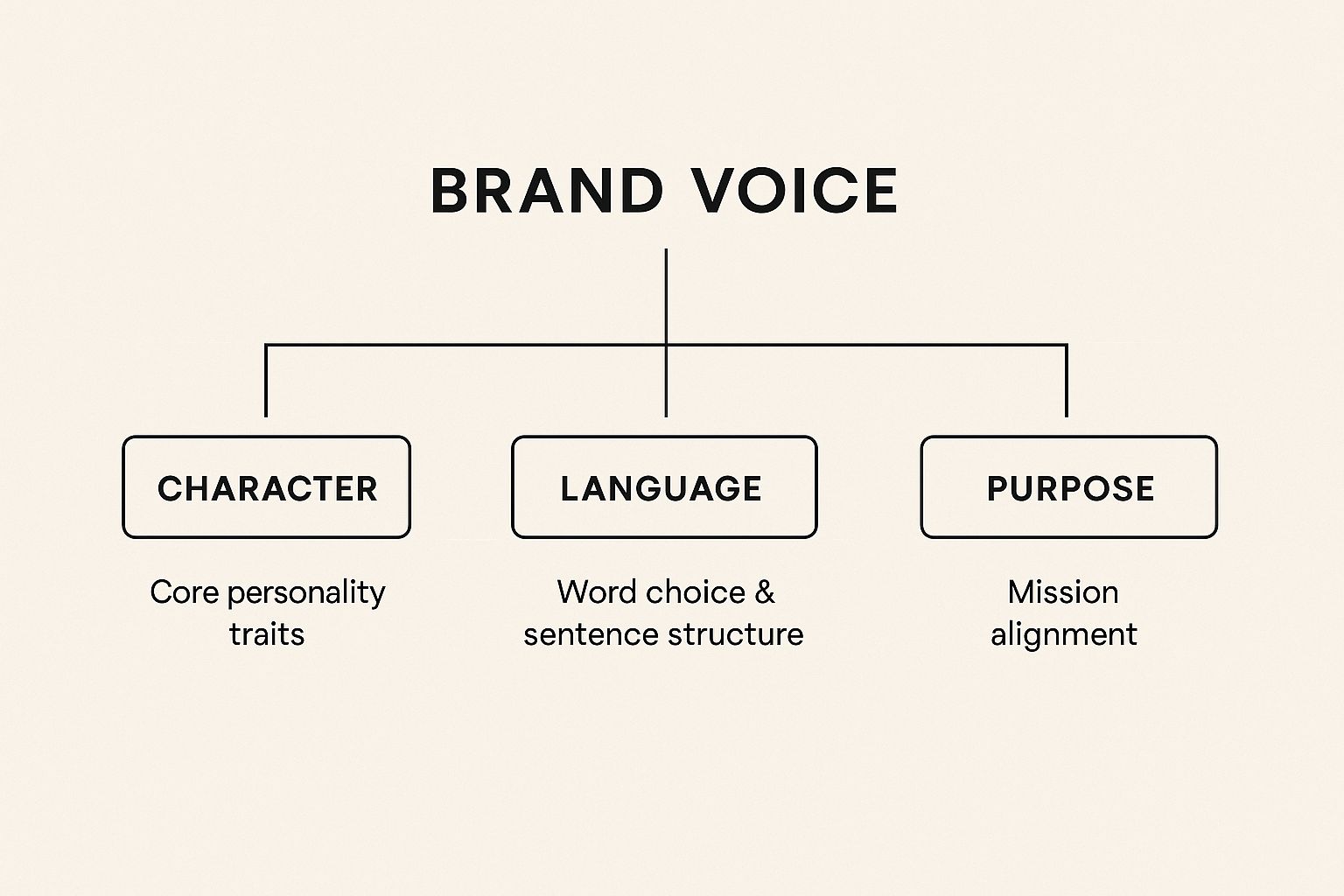
Have you ever wondered why some brands feel like a trusted friend while others are completely forgettable? The difference often comes down to one powerful element: brand voice. It’s not just what you say, but how you say it. Many creators and marketers struggle to maintain a consistent personality across all their channels, leading to a confusing and disconnected customer experience. This guide will demystify what brand voice is, why it’s critical for growth, and provide a step-by-step process to help you define a unique voice that builds trust and turns followers into loyal fans.
What Exactly Is a Brand Voice?
Think of brand voice as your brand's unique personality. It's the consistent expression of your values and persona through words. This voice shows up everywhere—from your website copy and social media posts to customer service emails and ad campaigns. A well-defined voice ensures your brand is instantly recognizable, no matter where your audience encounters it.

Defining your voice is a foundational step in building an effective communication strategy. For a deeper dive, this Ultimate Brand Voice Guide is an excellent resource. Of course, a great voice needs skilled writing to bring it to life. If you're looking to sharpen your skills, our guide on copywriting tips for beginners can help. Ultimately, a strong, consistent voice is what transforms one-time buyers into a loyal community.
Brand Voice vs. Brand Tone: What's the Difference?
To truly grasp what is brand voice, it's essential to distinguish it from its close cousin, brand tone. Many people use these terms interchangeably, but they represent two different layers of communication. Confusing them can lead to an inconsistent and jarring experience for your audience.

Defining Voice and Tone
Let's break it down with a simple analogy:
- Brand Voice is your personality. It’s the core of who your brand is—witty, authoritative, nurturing, or adventurous. This personality is stable and consistent over time. It's your foundation.
- Brand Tone is your mood. It’s the emotional inflection you apply to your voice depending on the context. Your tone must adapt to the situation, the platform, and the audience you're addressing.
A Real-World Example
Imagine your brand’s voice is helpful and professional. How would that voice adapt its tone in different scenarios?
- Celebrating a customer’s success on social media: The tone would be enthusiastic and encouraging. Think congratulatory language and celebratory emojis.
- Responding to a customer complaint: The tone would shift to be empathetic and apologetic. The language becomes more serious, focusing on understanding and resolving the issue.
- Writing a technical guide: Here, the tone is direct and clear. The goal is to provide straightforward instructions that are easy to follow.
In each case, the underlying helpful and professional voice remains constant. The brand doesn’t become unprofessional or unhelpful; it simply adjusts its emotional expression—its tone—to fit the context. Misjudging the situation can have a big impact, as research on the impact of tone on brand perception shows.
Why a Strong Brand Voice Drives Business Growth
In a crowded digital marketplace, a memorable brand voice isn’t just a creative extra—it’s a powerful engine for growth. When your voice is distinct, it creates a mental shortcut for your audience, helping them instantly recognize who you are and what you stand for. This recognition is the first step toward building a real relationship, whether a customer sees your brand on social media, in an email, or on a product page.
Building Trust Through Consistency
Consistency is the foundation of trust. We trust people who are predictable and whose words align with their actions. The same principle applies to brands. When your audience knows what to expect from you, they develop a sense of reliability and security. This is especially critical when using the best AI tools for content creation, as clear voice guidelines ensure every piece of content sounds uniquely like your brand, not a generic robot.
Fostering an Emotional Connection
Beyond building trust, a strong brand voice forges a genuine emotional bond. People don't just buy products; they buy into stories, values, and identities. Your voice is how you communicate these intangibles. Research confirms that people prefer to buy from brands they feel connected to, and they remain loyal to brands that share their values. You can discover more about how brand voice attracts business and powers these vital connections. When customers feel seen and understood, they become passionate advocates who drive sustainable growth.
The 4 Pillars of a Memorable Brand Voice
A great brand voice feels natural, but it’s built on a solid strategic foundation. To create a voice that is both memorable and consistent, you need to define its core components. Think of these four pillars as the framework that will guide every word you write, ensuring your communication is always authentic and on-brand.

Pillar 1: Character & Persona
First, define your brand's character. If your brand were a person, who would it be? A wise mentor, a witty friend, a passionate activist? This persona is the anchor for your entire voice. Start by choosing 3-5 core adjectives that capture your brand’s essence.
- Example (Fintech Startup): Authoritative, Accessible, Innovative.
- Example (Wellness Brand): Nurturing, Calm, Inspiring.
Pillar 2: Language & Vocabulary
Once you know who your brand is, decide how it speaks. This pillar covers the specific words, phrases, and sentence structures you'll use. Do you use industry jargon or simple, everyday language? Are your sentences long and descriptive or short and punchy? For example, a brand aiming to be "accessible" would avoid dense, academic terms.
Pillar 3: Tone & Emotion
As we covered, tone is the emotional inflection you apply to your voice. While your character is constant, your tone must adapt to different situations. This pillar involves mapping out the spectrum of emotions your brand can express while remaining true to its core persona.
- For an Authoritative character: Your tones might include Confident, Direct, and Formal.
- For a Nurturing character: You might use tones that are Supportive, Gentle, and Encouraging.
Pillar 4: Purpose & Mission
Finally, every great brand voice must be grounded in purpose. Why does your company exist? Your voice should be a direct channel for your core values and mission. This pillar connects your communication style back to your business strategy, ensuring every message reinforces what your brand stands for.
How to Find Your Brand Voice: A Step-by-Step Guide
Ready to move from theory to practice? Defining your brand voice is a strategic process, not a mysterious creative ritual. This guide will walk you through building a voice from the ground up, ensuring every word you publish feels intentional and authentic.

1. Audit Your Existing Content
Before you can decide where to go, you need to know where you stand. Gather a sample of your current communications—blog posts, social media updates, and email newsletters. Ask yourself:
- What patterns do you see? Are there inconsistencies between channels?
- What feels right? Identify content that genuinely sounds like your brand and has performed well.
- What feels off-brand? Pinpoint anything that sounds generic or disconnected from your company’s identity.
This audit will create your baseline and reveal the raw materials you can shape into a cohesive voice.
2. Deeply Understand Your Audience
You can't connect with people if you don't know who you're talking to. Go beyond basic demographics and dive into psychographics. How does your ideal customer talk? What language do they use in forums, social media, or reviews? Listen to their pain points, goals, and humor. Building detailed audience personas helps you shape a voice that meets them on their level. To learn more, check out our guide on SEO copywriting tips to make every word count.
3. Create a Brand Voice Chart
Now, make your voice tangible. A brand voice chart is a simple yet powerful tool that provides clear guardrails for your team. The "This, Not That" format is particularly effective.
| Characteristic | Use This | Not That |
|---|---|---|
| Friendly | "Let's find a solution together." | "Your ticket has been received." |
| Confident | "Here’s how to do it." | "You might want to try..." |
| Simple | "Easy-to-use tools" | "User-friendly solutions" |
This chart removes the guesswork, empowering everyone to communicate with one consistent voice. Using the right language has a real-world impact, and you can discover more insights about personalized communication to see the results for yourself.
👉 Try MediaWorkbench.ai for free – schedule your posts and generate AI content in one place!
Conclusion: Make Your Voice Your Greatest Asset
In the end, your brand voice is far more than just a marketing tactic. It's the core of your brand's identity and your most powerful tool for cutting through the noise. It’s how you build trust, foster genuine connections, and turn casual followers into a loyal community. By taking the time to define your voice, you create a strategic asset that ensures every piece of content works together to build a memorable and beloved brand. Now is the time to find your voice and make sure it gets heard.
Ready to scale your content without losing your unique voice? With MediaWorkbench.ai, you can train our AI on your brand's style guide to generate on-brand content in seconds. Try it for free today!

